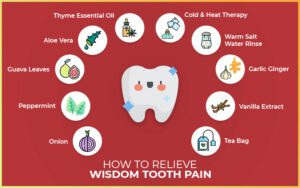Introduction
Wisdom teeth, which are scientifically referred to as third molars, typically make their appearance in the rear of your mouth during the late teens or early twenties. While they can be a valuable asset if they grow in properly and are aligned correctly, more often than not, they cause problems. This article provides detailed information on what to expect and how to prepare for wisdom teeth removal.
What Are Wisdom Teeth?
Understanding the Third Molars
Wisdom teeth, or third molars, are the final set of molars at the back of your mouth. The majority of individuals possess a total of four wisdom teeth, with a pair situated in the upper jaw and another pair in the lower jaw. These teeth typically begin to emerge during the late adolescent or early adult years.


Why Do Wisdom Teeth Need Removal?
Common Reasons for Extraction
- Overcrowding: Wisdom teeth can cause overcrowding, shifting other teeth out of alignment. Overcrowding can result in crooked teeth and misalignment issues.
- Impaction: Wisdom teeth often become impacted, meaning they don’t fully emerge from the gum line. Impacted wisdom teeth can lead to pain, infection, and other oral health problems.
- Pain and Discomfort: Impacted or misaligned wisdom teeth can lead to pain and discomfort, particularly in the back of your mouth.
- Infection: Partially erupted wisdom teeth can create pockets where bacteria can grow, leading to infection. This can result in gum inflammation and pain.
Signs and Symptoms
How to Recognize Wisdom Teeth Issues
Signs that your wisdom teeth may need removal include:
- Pain or discomfort at the back of your mouth: Wisdom teeth-related pain is often felt at the rear of your mouth.
- Swelling and tenderness: The gum tissue around the emerging or impacted wisdom teeth can become swollen and tender.
- Jaw stiffness: You may experience jaw stiffness, making it difficult to open your mouth fully.
- Bad breath or an unpleasant taste: Infections around wisdom teeth can lead to bad breath and an unpleasant taste in your mouth.
Consultation with a Dentist
The First Step
If you’re experiencing any of the mentioned signs or are in the age range when wisdom teeth typically emerge, it’s crucial to consult your dentist. The first step is to schedule an appointment with your dentist, who will perform an examination to determine whether removal is necessary.
During this consultation, your dentist may take X-rays to get a better look at the position and alignment of your wisdom teeth. Based on the findings, they will advise you on the best course of action.
Preparing for Wisdom Teeth Removal
Getting Ready for the Procedure
Preparing for wisdom teeth removal involves several important steps:
Understanding the Procedure: Learn about the removal process to ease any anxieties. Your dentist will explain the steps involved in detail.
It’s crucial to make arrangements for transportation as you’ll require someone to drive you back home following the surgery. This precaution is necessary as the effects of anesthesia may still be present, affecting your ability to drive safely.
Fasting: Follow any fasting instructions provided by your dentist. Typically, you should avoid eating or drinking for a specified period before the surgery to prevent complications.


The Procedure
What Happens During Removal
Wisdom teeth removal is typically an outpatient procedure, and it involves several steps:
- Anesthesia: You’ll receive local or general anesthesia to ensure a painless and comfortable experience during the procedure. The type of anesthesia used will depend on your dentist’s recommendations and your personal preferences.
- Extraction: The dentist will remove the wisdom teeth. This may involve cutting the gum or breaking the tooth into smaller pieces for easier removal, especially in the case of impacted teeth.
- Stitches: In some cases, stitches are needed to close the wound after the teeth are removed. The type of stitches and the need for them will be determined by your dentist.
Recovery Period
Healing and Recovery
The recovery period after wisdom teeth removal may last several days to a couple of weeks. During this time, you’ll need to take some precautions:
- Pain Management: You’ll be given pain medication by your dentist to manage any discomfort. Follow your dentist’s instructions for taking these medications.
- Swelling: It’s common to experience swelling and bruising following the procedure. Applying ice packs to the affected area can help reduce swelling and discomfort.
- Diet: Stick to a soft-food diet for a few days to allow your mouth to heal properly. Soft foods are easier to chew and won’t put excess pressure on the surgical sites.
Managing Pain and Discomfort
Coping with Post-Surgery Pain
To manage pain and discomfort effectively:
- Follow Medication Instructions: Take pain relievers as directed by your dentist. It’s important to follow the recommended dosage and schedule.
- Rest: Ensure you get an ample amount of rest during the initial phase of your recovery. Avoid strenuous physical activities, as rest is essential for the healing process.
- Oral Care: Be gentle when brushing your teeth and avoid the surgical area. Your dentist may provide specific instructions for oral hygiene during the recovery period.
Diet and Nutrition After Removal
What to Eat During Recovery
During the initial recovery phase, it’s essential to choose foods that won’t irritate the surgical sites. Consider including the following in your post-removal diet:
- Soups: Broth-based soups are easy to consume and provide necessary nutrients.
- Yogurt: Soft and cool yogurt is soothing and helps maintain nutrition.
- Mashed Potatoes: These are easy to chew and swallow without causing discomfort.
- Smoothies: Fruit smoothies are both nutritious and refreshing.
Potential Complications
Be Informed
While complications after wisdom teeth removal are relatively rare, it’s essential to be aware of potential issues, including:
- Infection: There are instances where an infection might occur at the surgical site. This can usually be treated with antibiotics prescribed by your dentist.
- Dry Socket: Dry socket is a condition where the blood clot that normally forms after extraction is dislodged or dissolves, exposing the bone. This can be painful but is treatable.
- Nerve Damage: Although rare, damage to nearby nerves can occur during the extraction process.This could result in temporary numbness or, in rare instances, lasting tingling sensations in the lips, tongue, or chin.
When to Contact Your Dentist
Post-Operative Concerns
If you experience any of the following post-surgery concerns, contact your dentist promptly:
- Severe, persistent pain that is not relieved by prescribed medication.
- Excessive bleeding that continues beyond the first day.
- Swelling that worsens instead of improving.
- High fever or signs of infection, such as pus at the surgical site.
- Your dentist is there to support you during the recovery process, so don’t hesitate to reach out with any concerns.
Frequently Asked Questions (FAQs)
Your Queries Answered
Q1: Is wisdom teeth removal painful?
A1: While there may be discomfort, the procedure itself is not painful due to anesthesia. Discomfort can be managed with prescribed pain medication.
Q2: How long does the procedure take?
A2: The duration depends on the complexity of the extraction but typically ranges from 45 minutes to one hour.
Q3: Can I go back to work or school the next day?
A3: It’s recommended to take at least one day off to rest and recover. Some individuals may need more time, depending on their healing process.

Leave a Reply